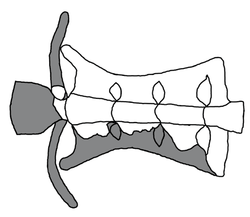Brachiosaurus nougaredi
| "Brachiosaurus" nougaredi Temporal range: Early Cretaceous, 112–96 Ma | |
|---|---|
 | |
| Reconstructed sacrum | |
| Scientific classification | |
| Kingdom: | Animalia |
| Phylum: | Chordata |
| Class: | Reptilia |
| Superorder: | Dinosauria |
| Order: | Saurischia |
| Suborder: | †Sauropodomorpha |
| Infraorder: | †Sauropoda |
| (unranked): | †Titanosauriformes |
| Family: | incertae sedis |
| Species | |
| |
"Brachiosaurus" nougaredi was a giant sauropod dinosaur of uncertain affinities. It was originally assigned to the genus Brachiosaurus in 1960, though it certainly represents a different genus, and probably a different family.
This species is known from fragmentary remains discovered in eastern Algeria, in the Sahara Desert. The present type material consists of a sacrum and some of the left metacarpals and phalanges. Found at the discovery site but not collected were partial bones of the left forearm, wrist bones, a right shin bone, and fragments that may have come from metatarsals.[1] Albert-Félix de Lapparent, who described and named the material in 1960, reported the discovery locality as being in the Late Jurassic–age Taouratine Series (he assigned the rocks this age in part because of the presumed presence of Brachiosaurus),[1] but more recent review assigns it to the "Continental intercalaire," which is considered to be of Albian age (late Early Cretaceous, significantly younger).[2]
"Brachiosaurus" nougaredi was formerly considered to be a species of Brachiosaurus,[1] or a distinct, unnamed brachiosaurid,[2] but a more recent analysis finds that the remains probably belong to more than one species.[3] The metacarpals were found to belong to an indeterminate Titanosauriform. Because the sacrum's current location is unknown, it was not analyzed and considered an indeterminate sauropod until its rediscovery. Only four out of the five sacral vertebrae are preserved, but the preserved portion alone measures 1.3 metres (4.3 ft) long, larger than any other sauropod sacrum ever found, except Argentinosaurus and Apatosaurus.[3] When complete, the sacrum may have been as long as 1.45 metres (4.8 ft), making it the largest sauropod sacrum ever found.
References
- 1 2 3 de Lapparent, A.F. (1960): "Les dinosauriens du "continental intercalaire" du Sahara central" ("The dinosaurs of the "continental intercalaire" of the central Sahara.") Mémoires de la Société Géologic de France, Nouvelle Série 88A vol.39(1–6):1–57. [in French; a translated version, by Matthew Carrano (pdf, no figures), is available through the Polyglot Paleontologist]
- 1 2 Upchurch, P., Barrett, P.M. & Dodson, P. (2004). "Sauropoda", pp. 259–322 in Weishampel, D.B., Dodson, P. & Osmólska, H. (Eds.) The Dinosauria, 2nd edition. University of California Press, Berkeley and Los Angeles. ISBN 0520254082.
- 1 2 Mannion, Philip D.; Upchurch, Paul; Barnes, Rosie N.; Mateus, Octávio (2013). "Osteology of the Late Jurassic Portuguese sauropod dinosaur Lusotitan atalaiensis (Macronaria) and the evolutionary history of basal titanosauriforms" (PDF). Zoological Journal of the Linnean Society. 168: 98–206. doi:10.1111/zoj.12029.